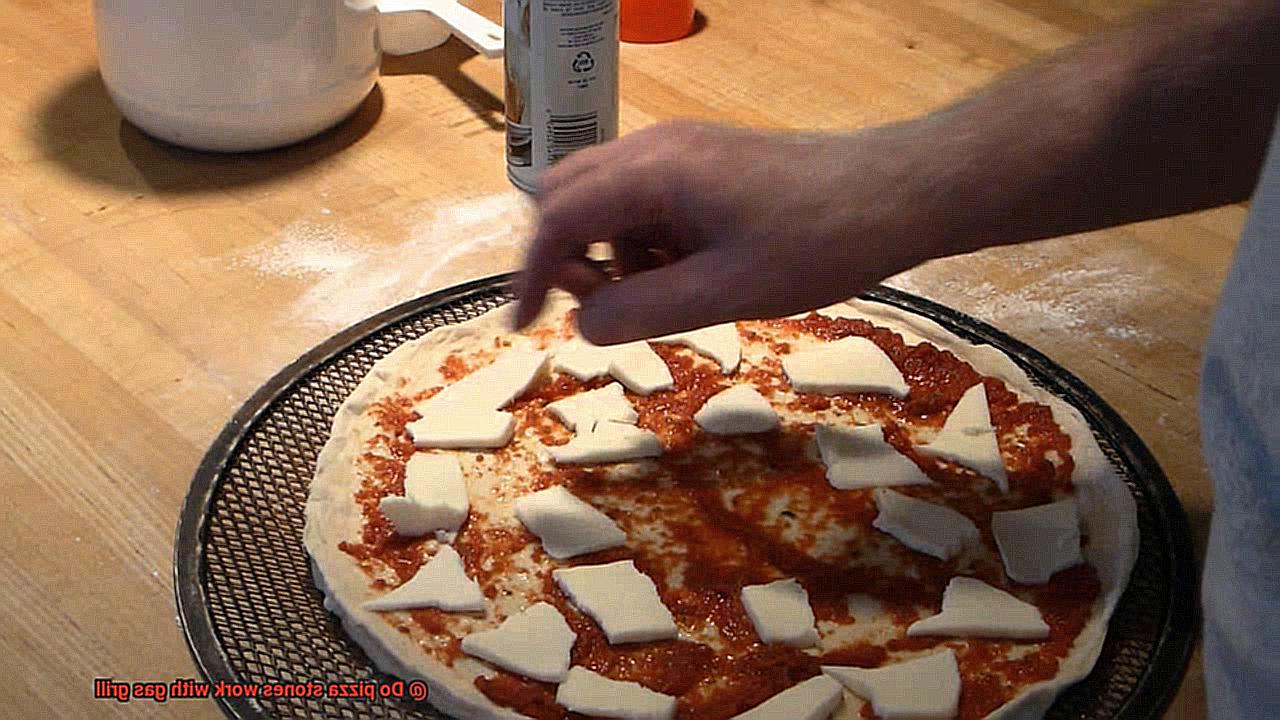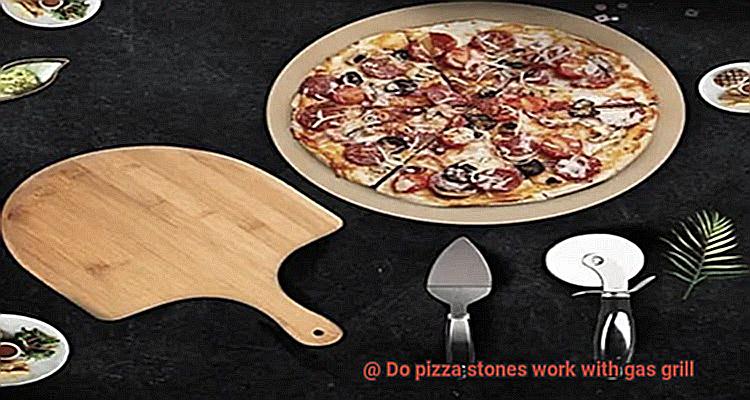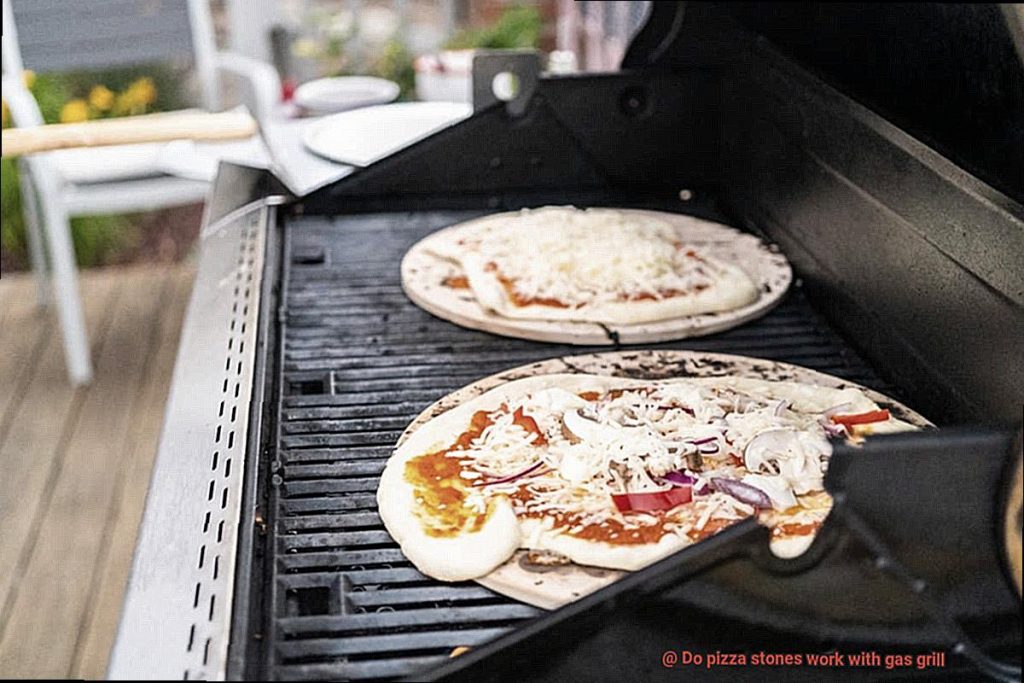Pizza. The mere mention of the word can make your mouth water and your stomach growl. It’s no secret that pizza is one of the most beloved foods worldwide, with its endless topping options and crispy crusts that are simply irresistible. But what if you don’t have access to a traditional wood-fired oven? Can pizza stones work with gas grills too?
If you’re a pizza aficionado looking for answers, you’ve come to the right place. In this blog post, we’ll delve into whether pizza stones can work their magic on gas grills and show you how to use them to create pizzas that will leave your taste buds dancing.
But before we dive in, let’s address the elephant in the room – do pizza stones really make a difference? The answer is a resounding yes. Pizza stones help maintain high temperatures and distribute heat evenly throughout the pie, resulting in a perfectly crispy crust. When used correctly, they can even mimic the effects of a wood-fired oven.
So now that we’ve established that pizza stones are indeed worth their weight in cheese, let’s explore how they work with gas grills. We’ll walk you through the specific steps to follow and share some tips to ensure your pizzas turn out just right. Get ready to impress your friends and family with mouth-watering pizzas cooked on your trusty gas grill.
Contents
What is a Pizza Stone?
Look no further than the humble pizza stone. But what exactly is a pizza stone and why is it such a game-changer?
A pizza stone is a flat, round slab made of natural materials like ceramic, clay, or stone. It’s designed to absorb and distribute heat evenly, mimicking the effect of a brick oven. This means that when you place your pizza on top of a preheated pizza stone, it cooks evenly and results in perfectly crispy crust every time. Pizza stones come in various shapes and sizes, but they’re typically around 14 inches in diameter and 1/2 inch thick.
But don’t be fooled – pizza stones are not just for pizzas. They’re also great for baking bread, pastries, and even roasting vegetables or meats. The versatility of pizza stones makes them an invaluable tool for any home cook.
To use a pizza stone, simply preheat it in your oven or on your gas grill before placing the pizza on top. This ensures that the stone is hot enough to cook the pizza evenly. The porous nature of the stone helps to absorb any excess moisture from the dough, resulting in an even crispier crust while keeping the toppings moist and flavorful.
When using a pizza stone on your gas grill, there are a few essential steps to follow. First, preheat the stone to ensure that it’s evenly heated. Then, place the stone directly on the grill grates once it’s reached the desired temperature. Keep an eye on your pizza while it’s cooking and adjust the temperature of your grill as needed.
One important tip when using a pizza stone is to dust it with cornmeal or flour to prevent sticking. And don’t forget to let your pizza rest for a few minutes after taking it out of the oven or off the grill – this allows the crust to crisp up even more.
Benefits of Using a Pizza Stone on a Gas Grill
If so, using a pizza stone on your gas grill may be the solution you’ve been looking for. Here are just a few of the benefits you can expect when using a pizza stone:
- Even heat distribution: A pizza stone is designed to absorb and distribute heat evenly, resulting in a perfectly cooked crust and toppings. By transferring heat evenly, the stone ensures that your pizza cooks consistently throughout, without any undercooked or burnt spots.
- Regulated temperature: By using a pizza stone on your gas grill, you can also regulate the temperature of the grill itself. This means you won’t have to worry about hot spots or inconsistent cooking temperatures that can ruin your pizza. Instead, you can trust that your pizza will cook at a consistent temperature from start to finish.
- Faster cooking time: Because the pizza stone absorbs and retains heat, it can actually help to cook your pizza faster than if it were just placed directly on the grill. This means you can enjoy your homemade pizza in less time than it might take otherwise.
- Improved taste and texture: One of the biggest benefits of using a pizza stone is how it improves the overall taste and texture of your pizza. The high temperature of the stone helps to create a crispy crust while keeping the toppings moist and flavorful. This means you can enjoy restaurant-quality pizza right in your own backyard.
How to Preheat the Pizza Stone on a Gas Grill
Using a pizza stone on a gas grill is a great way to achieve that authentic wood-fired taste. However, it’s crucial to preheat the pizza stone before using it to ensure optimal performance. Here are five simple steps to preheat your pizza stone on a gas grill:
Step 1: Clean the Pizza Stone
Before preheating, make sure your pizza stone is clean and free from any debris. Any dirt or moisture on the stone can cause it to crack when exposed to high temperatures. Once you have cleaned the pizza stone, place it on the gas grill grates, and close the lid.

Step 2: Set the Gas Grill to High Heat
Next, turn on all the burners of your gas grill and set them to high heat. Allow the grill to preheat for at least 15 minutes, or until the temperature reaches 500-550 degrees Fahrenheit. This will ensure that the pizza stone is heated evenly and thoroughly.
Step 3: Test the Temperature of the Pizza Stone
To test if your pizza stone has reached the desired temperature, you can sprinkle a few drops of water on it. If the water sizzles and evaporates immediately, then it is ready for use. If not, let it heat up for a few more minutes before testing again.
Step 4: Place Your Pizza on the Stone
Once your pizza stone has reached the desired temperature, use tongs to carefully remove it from the grill. Be sure to use oven mitts or gloves to protect your hands from the hot stone. Now, place your prepared pizza dough or frozen pizza onto the preheated stone using a pizza peel or spatula.
Step 5: Monitor Your Pizza
Keep an eye on your pizza while it’s cooking and adjust the temperature of your grill as needed. One thing to keep in mind when using a pizza stone on a gas grill is that it may take longer to cook your pizza than it would in an oven. This is due to the fact that the grill may not be able to maintain a consistent temperature as well as an oven can.
Placing the Pizza Stone on the Grill Grates
Imagine the sizzling sound of a pizza baking on a stone, infused with the smoky flavor of your gas grill. But wait. Before you start rolling out dough, it’s crucial to know how to place the pizza stone on your grill grates.
Firstly, ensure that your grill grates are squeaky clean and free of any debris. Any leftover food particles or grease can stick to the stone and potentially ruin your pizza. Once the grates are spotless, it’s time to place the pizza stone on them.
But be careful. The stone must be placed on a level surface on the grill grates. If you don’t, it can cause uneven cooking, resulting in a soggy or burnt crust and ultimately ruining your pizza. So take a minute to check that the stone is level before you start cooking.
Now it’s time to preheat your grill and pizza stone. This step is crucial to ensure even heating of the stone throughout, promoting evenly cooked pizzas. Most pizzas are cooked at high temperatures, so preheating your pizza stone for at least 30 minutes before cooking is recommended.
Pro tip: preheat your grill and stone together to ensure they reach the same temperature.
Another thing to consider when placing your pizza stone on a gas grill is its size. It’s best to use a pizza stone that fits comfortably on your grill grates without touching the sides. If the stone is too large, it can cause uneven heating and potentially damage your grill.
To summarize, here’s a checklist for placing your pizza stone on your gas grill:
- Clean the grill grates thoroughly
- Check that the pizza stone is placed on a level surface
- Preheat both the grill and pizza stone for at least 30 minutes
- Use an appropriately sized pizza stone for your grill
Cooking Time for Pizzas with a Pizza Stone on a Gas Grill
Look no further than cooking your pizza on a gas grill with a pizza stone. As an expert on this topic, I have compiled some research notes to guide you on the ideal cooking time and temperature for your pizza.
Firstly, preheating your grill is crucial before cooking your pizza. Allow at least 15-20 minutes for the grill to reach the optimal temperature between 450°F to 500°F. Once it’s hot enough, place the pizza stone on the grill grates and close the lid to get it heated up.
Next, let the pizza stone heat up for at least 10-15 minutes before placing your pizza on it. This will ensure that the stone is evenly heated and will prevent sticking. Once you’re ready to cook your pizza, place it on the preheated stone and close the lid.
The cooking time for a pizza on a gas grill with a pizza stone can range from 8-15 minutes depending on the thickness of the crust. Thicker crusts will take longer to cook while thinner crusts may cook faster. Keep an eye on your pizza and look for a golden brown crust and bubbly cheese to know when it’s done. You can also lift up one side of the pizza with a spatula or tongs to check if the bottom is crispy and browned.

It’s worth noting that cooking time may vary depending on your specific grill and weather conditions. That’s why it’s essential to keep an eye on your pizza while it’s cooking to ensure that it doesn’t burn or overcook.
Tips for Getting Perfectly Cooked Pizzas on the Grill
There’s nothing quite like biting into a perfectly cooked pizza with a crispy crust and mouth-watering toppings. And when it comes to grilling pizzas on a gas grill, using a pizza stone can make all the difference. Here are some tips for getting that perfect pizza on the grill with a pizza stone:
Preheat the Pizza Stone
Preheat your grill and pizza stone for at least 30 minutes to ensure even cooking. This allows the stone to absorb heat and ensure that the crust cooks evenly.
Choose the Right Dough
Thinner crusts work best for grilling, as they cook more evenly and quickly. Opt for a dough with high gluten content, as this will help it hold up better on the grill.
Keep it Simple with Toppings
Less is often more when it comes to toppings on a grilled pizza. Too many toppings can weigh down the pizza and prevent it from cooking evenly. Stick to a few high-quality toppings for best results.
Keep an Eye on Your Pizza
It’s crucial to monitor your pizza while it’s cooking on the grill. Rotate it occasionally to ensure that it cooks evenly and adjust the temperature of the grill as needed to prevent burning or undercooking.
Let Your Pizza Cool Before Serving
Once your pizza is cooked to perfection, resist the urge to dive right in. Let it cool for a few minutes before slicing and serving. This allows the cheese to set and prevents any toppings from sliding off.
Cleaning and Maintenance of the Pizza Stone
In our previous section, we indulged in the art of grilling the perfect pizza using a pizza stone. But what comes after the delicious meal? It’s time to clean and maintain your trusty pizza stone. In this section, we’ll share some tips on how to keep your pizza stone in pristine condition.
First and foremost, allow your pizza stone to cool down completely before cleaning it. Rushing to clean it while it’s still hot can lead to disastrous results such as cracking or breaking. So exercise patience and wait until it has completely cooled down. Once cooled, use a brush or scraper to remove any excess food particles or debris. You can either use a stiff-bristled brush or a plastic scraper, but make sure to be gentle while cleaning the surface to avoid causing any damage.
If there are any stubborn stains or burnt-on bits of food, don’t fret. Simply use a damp cloth or sponge with a small amount of mild detergent to clean it up. However, harsh chemicals or abrasive cleaners should be avoided as they can negatively affect the taste of your pizzas and damage the surface of your pizza stone.
After cleaning, ensure that you dry the pizza stone completely before storing it away. Any moisture left on the stone can encourage mold growth or cause it to crack if stored in a cold environment.
Moving onto maintenance, avoiding exposing your pizza stone to extreme temperature changes is crucial to its longevity. This means not placing a cold pizza stone directly into a hot oven or onto a hot grill. Gradually bringing up the temperature by placing it in a cool oven or on a cool grill and slowly heating it up is key.
Last but not least, refrain from using metal utensils on your pizza stone. Metal utensils can scratch its surface and damage its non-stick properties. Instead, opt for wooden or silicone utensils when cooking on your pizza stone.
zgCvbDfIOuE” >
Conclusion
In conclusion, pizza stones are a game-changer for gas grill enthusiasts who crave that authentic wood-fired taste. With the help of a pizza stone, you can achieve mouth-watering pizzas with perfectly crispy crusts without leaving your backyard. But it’s not just limited to pizzas; these versatile tools can also be used for baking bread, pastries, and even roasting vegetables or meats.
To get the most out of your pizza stone on a gas grill, there are a few key things to keep in mind. Preheating the stone properly and placing it on a level surface on the grill grates is crucial for even cooking. Cooking times can vary depending on crust thickness but generally range from 8-15 minutes. Keep an eye on your pizza while it’s cooking to avoid burning or overcooking.
For perfect results every time, follow these tips: preheat the pizza stone, choose the right dough, keep toppings simple, monitor your pizza while it cooks, and let it cool before serving.
Maintenance is also essential for extending the life of your pizza stone. Allow it to cool down completely before cleaning and avoid exposing it to extreme temperature changes. Opt for wooden or silicone utensils instead of metal when handling your stone.
Overall, using a pizza stone on a gas grill is an excellent way to enjoy delicious homemade pizzas with perfectly crispy crusts right in your own backyard.






